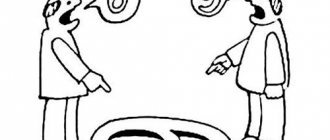How to raise the authority of the class teacher?
Hello. Please give me some advice. I have big problems with the 6th grade in which I am the class teacher. Thank God, I still have good relations with the other classes where I teach. The class at school is considered difficult, but at first I did not have such problems. By the end of the 5th grade, they began to become unruly and did not obey the requirements of the class teacher. There are 3 “difficult” children.
1) Vika is an excellent student, a leader, a head girl, but prone to deviant acts (I mean theft) and in general, she has the trait of ruling over other guys by humiliating their dignity, but only she is inclined to obey her. The girl’s mother works in a library and is a teacher by training. The father is a drinker and unemployed, very violent when drunk.
2) Nikita is a leader, capable of studying well, but due to laziness he does not carry out homework, is easily excitable, unbalanced, grows up without a father, his mother works a lot. The boy strives to be friends with high school students and loves the company of adult men, from whom he adopts boorish manners.
3) Ruslan, who is treated like a jester in class. Very unbalanced, underperforming, and flatly refusing to do his homework. His mother is also alone, besides him she has 2 adult children and a grandson, they all live together, his mother works a lot, the family is low-income.
Possible forms of behavior disorders in outcast children
Behavioral disorders (deviance) are very common among children who are subject to persecution and bullying.
Often outcasts at school are capable of the following deviations:
- Theft. A child may steal to buy something for himself and numb the pain. May steal to buy something for other children/adults and thereby earn their favor, friendship, love, recognition.
- Lie. An outcast child may begin to lie not only to his parents, but also to his peers. Inventing stories that don’t exist in order to increase your “points” in the eyes of others. As a rule, stories are chosen that are capable of causing envy: about rich relatives, boxing brothers, prestigious things in the family's possession (cars, clothes, jewelry). Fantasies can be the most incredible, and one day there is someone in the team who exposes the child to clean water, and those very “points” of the unpopular child fall even lower.
- Suicide attempts. Problems discovered in a child at the wrong time, the advanced nature of bullying, and the indifference of school staff can lead the child to thoughts of suicide. They do not always take on a real character, but the child’s dominant in the selection of information shifts. He begins to visit unnecessary sites, antisocial individuals become authorities, and strange friends appear.
- Robbery. An angry child who is being bullied in one group may try to indirectly get even with his offenders in another by acting as the instigator of bullying. The lack of control over such processes can force a child to cross the line of the law. This is especially true in adolescence, when the child is already responsible for offenses before the law, and sensitivity to the concepts of permitted and not permitted has not yet been formed. In outcast children it may remain unformed at all.
How can parents determine if their child has become a school outcast?
Yes, it is possible to recognize in time that a child is an outcast in the class. What should parents do in this case? Be attentive to the child’s needs, listen to him, and do not deny the problem.
Just suspect something is wrong if the child:
- has lost the desire to go to school or is already missing classes;
- does not invite friends from school to visit;
- avoids questions about school, does not want to talk about grades and classmates;
- is in a pronounced emotional slump every day after school;
- ignores holidays and class meetings;
- does not maintain a page on a social network or does not have classmates as friends;
- does not call back with classmates;
- often cries for no reason without explanation;
- has physical or sociocultural signs of deviations from the norm (overweight, braces, lameness, blindness, squint, stuttering, dark skin, accent, oriental eyes, etc.) and suddenly begins to be ashamed of them.
Source
One hundred percent
One hundred percent is the number of students who should listen to the teacher in class. “Is this from the realm of science fiction?” - you ask. Not at all. You just need to know some subtleties. The best teachers achieve obedience through positive and, importantly, unobtrusive measures. One hundred percent of attention is achieved through the skillful use of three principles.
Correction should not be intrusive or aggressive. One hundred percent attention is needed so that you can teach the lesson. If you make your way to this goal through a thicket of constant comments, you will end up with a vicious circle. By reprimanding one student, you distract everyone from the lesson, even those who are listening to you. Therefore, it is necessary to maintain discipline without deviating from the topic of the lesson and with minimal loss of time. We offer six types of unobtrusive correction in order of intensification. Try to resort to the first provisions on the list as often as possible.
- Nonverbal correction. Contact the offender with gestures or glances, without distracting from the topic of the lesson. For example, gesture to the student to lower their hand while you speak.
- Positive group correction. Do not talk again about what the student should not do. Briefly remind the entire class what the student should be doing during class. For example: “Everyone reads in turn; the rest are watching the person in charge.” Use this skill when you notice that students' attention is about to wander. The sooner you remind, the better.
- Anonymous individual correction. Give brief reminders to the class as described above, but in this case emphasize that not everyone is doing what they need to do. For example: “We wait for the two to be silent; everyone must look at the person answering.”
- Individual correction. If you have to address the student personally, make the remark without others noticing. Approach the offender’s desk, bend over and, trying not to distract others, quickly and quietly express your request. Then continue the lesson. For example: “Quentin, I asked everyone to listen to me, and I would like you to do the same.”
- Instant public correction. It is not always possible to make a remark without others noticing. Public correction will allow you to limit the amount of attention to the offender and explain what is expected of him, rather than scolding or telling him what he did wrong. For example: “Quentin, where are you looking? Rear desks, don’t yawn!”
- Punishment. If you cannot quickly resolve the situation without resorting to extreme measures, try not to disrupt the lesson. As with other types of correction, punishment should be quickly, unobtrusively and without unnecessary emotions. Ideally, a teacher should have an arsenal of techniques to adequately respond to any disruption and deal with it decisively and without hesitation.
Be firm and calm
- Catch it early. The best teachers instantly notice when a student's eyes begin to wander and stop his bad intentions before he can do anything.
- Gratitude has great power. Simply acknowledging that a student complied with your request not only demonstrates good manners, but also conveys to the entire class that the bad boy did what you asked. (Think about what else you could thank the student for.) Attention is restored, and students perceive you as a calm, well-mannered teacher who has everything under control.
- A means, not an end. Attention is a means, not an end. Students need to listen to you to succeed in their studies. “Look at me, otherwise you won’t understand” - this phrase will say much more than this: “Everyone should look at the teacher. If I ask you to do something, you must do it.”
- Universal requirements. Teachers who have perfectly mastered this technique emphasize the universality of the requirements. They express it this way: “I want everyone to sit up straight,” or better yet, “We should all sit up straight.” These phrases emphasize the unity of demands in contrast to this model: “Look at the teacher, Trevor.”
Focus on visible aspects of behavior
- Achieve maximum visibility. Find the right way to make discipline violators easy to detect. Do not demand abstract attention from students, but ask them to look at the teacher - this action is easier to track. Better yet, ask to put down your pencil and look at the teacher. Now you are observing the implementation of two instructions, and tracking the first - putting down a pencil - is much easier than noticing whether the whole class is looking at the teacher.
- Show that you are in control. Don't just give directions, but also monitor their implementation, and the students must understand that you are not asleep. Every couple of minutes, look around the class with a calm smile to check that everything is going according to plan. Before asking for anything, be sure to pause and look at the students. Say everything you see: “Thank you, Peter. Thank you, Marissa. First row, look at me." This emphasizes that you are watching everyone and noticing who is doing what, as if you had a “radar.”











